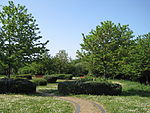Oxgate Admiralty Citadel
Oxgate Admiralty Citadel is the name given to a military bunker constructed between 1937 and 1940, for the Admiralty, on the corner of Edgware Road and Oxgate Lane, in north London. The citadel was designed to be an away-from-Whitehall base for admiralty operations, useful in the event of a need to evacuate the centre of London. The location was a mile from the Paddock, an alternate Cabinet War Room bunker for Winston Churchill's World War II government. The citadel comprises a three-storey building above ground (typical of government building vernacular), with an upper basement and a specially protected lower basement. It was used between 1939 and 1944, thereafter being given over to the Health & Safety Executive; nowadays it is in private hands.
Excerpt from the Wikipedia article Oxgate Admiralty Citadel (License: CC BY-SA 3.0, Authors).Oxgate Admiralty Citadel
Oxgate Lane, London Dollis Hill (London Borough of Brent)
Geographical coordinates (GPS) Address Nearby Places Show on map
Geographical coordinates (GPS)
| Latitude | Longitude |
|---|---|
| N 51.5681 ° | E -0.2297 ° |
Address
Oxgate Lane
Oxgate Lane
NW2 7HS London, Dollis Hill (London Borough of Brent)
England, United Kingdom
Open on Google Maps








